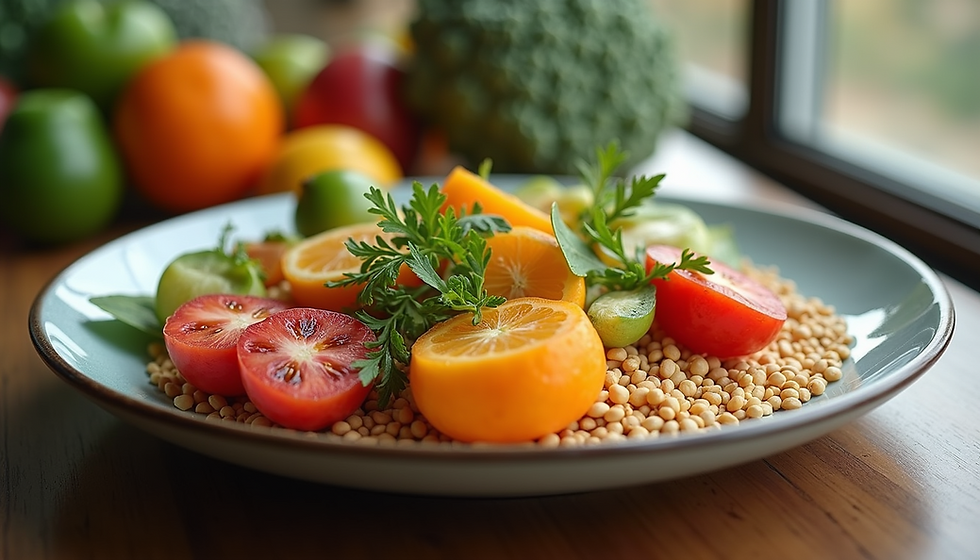Five Essential Nutrients Often Lacking in Hyperactive Children and How to Boost Them
- Alyssa S
- 24 hours ago
- 4 min read
Hyperactivity in children can be a challenging issue for parents and caregivers. While behavioral strategies and therapies are important, nutrition plays a crucial role that is sometimes overlooked. Research shows that certain nutrients may be low in children with hyperactivity, potentially contributing to their symptoms. This post explores five essential nutrients frequently lacking in hyperactive children and offers practical tips on how to boost their intake.

Omega-3 Fatty Acids
Omega-3 fatty acids are crucial for brain health and development. They play a significant role in cognitive function and emotional regulation. A study published in the Journal of Attention Disorders found that about 40% of children with ADHD had low omega-3 levels, affecting their attention and behavior.
To boost omega-3 fatty acids in your child's diet, incorporate:
Fatty Fish: Salmon, mackerel, and sardines are excellent sources. Aim to include these in your child's meals at least twice a week. For example, try including grilled salmon with vegetables or a sardine salad.
Flaxseeds and Chia Seeds: Rich in alpha-linolenic acid (ALA), these seeds can be sprinkled on oatmeal or blended into smoothies. Just two tablespoons of ground flaxseeds can provide a significant omega-3 boost.
Walnuts: A healthy snack, walnuts offer another plant-based source. A handful can provide your child with nearly 2.5 grams of omega-3s.
By ensuring your child gets enough omega-3 fatty acids, you may support their focus and reduce hyperactive behaviors.
Magnesium
Magnesium is vital for many bodily functions, including muscle and nerve function. Research indicates that children with hyperactivity often have lower magnesium levels. A study found that nearly 50% of children with ADHD had significantly reduced magnesium levels, leading to increased irritability.
To enhance magnesium intake, consider these sources:
Leafy Greens: Spinach, kale, and Swiss chard are packed with magnesium. Adequately integrating these into meals can be simple; add spinach to omelets or toss kale into salads.
Nuts and Seeds: Almonds, cashews, and pumpkin seeds can be nutritious snacks. For example, a 1-ounce serving of almonds provides about 75 mg of magnesium.
Whole Grains: Foods like brown rice and quinoa are good options. A cup of cooked quinoa contains approximately 118 mg of magnesium.
Boosting magnesium-rich foods in your child's diet may foster a calmer demeanor and improved focus.
Zinc
Zinc is an essential mineral that supports brain function and behavior. Research shows that children with ADHD often have lower zinc levels. Approximately 30% of children diagnosed with ADHD were found to have suboptimal zinc levels, which can influence cognitive abilities and emotional regulation.
To boost zinc levels, consider the following foods:
Meat and Poultry: Beef, chicken, and turkey are rich in zinc. A serving of beef can provide around 5-9 mg of zinc, depending on the cut.
Legumes: Beans, lentils, and chickpeas are great plant-based sources. One cup of cooked lentils offers about 6.6 mg of zinc, making them a great addition to soups or salads.
Dairy Products: Cheese and yogurt not only provide zinc but also calcium. For example, one cup of yogurt contains about 1.2 mg of zinc.
Increasing zinc intake may enhance your child's attention span and lessen hyperactive symptoms.
Iron
Iron is critical for producing hemoglobin, which carries oxygen in the blood. Low iron levels can lead to fatigue and decreased cognitive function. Research indicates that approximately 20% of children with ADHD may have iron deficiency, which could worsen hyperactive behaviors.
To boost iron levels, consider these dietary sources:
Red Meat: Beef and lamb are rich in heme iron, easily absorbed by the body. Including these in your child's diet can significantly improve iron levels.
Poultry and Fish: Chicken and fish also provide heme iron. A 3-ounce serving of cooked chicken offers around 0.9 mg of iron.
Plant-Based Sources: Beans, lentils, and fortified cereals are great non-heme iron sources. Pair these with vitamin C-rich foods like oranges or bell peppers to enhance absorption.
By ensuring your child gets enough iron, you may support their energy levels and cognitive function.
Vitamin D
Vitamin D is essential for overall health, including brain development. Research suggests that many children with hyperactivity may have lower levels of vitamin D. In fact, studies show that nearly 35% of children with ADHD are found to be deficient in this crucial vitamin, which affects mood and behavior.
To boost vitamin D levels, consider the following sources:
Sunlight: Encourage outdoor playtime, as sunlight is a natural source of vitamin D. Just 10-30 minutes of sun exposure can help produce adequate levels for your child.
Fatty Fish: Salmon and mackerel are once again highlighted. A 3.5-ounce serving of cooked salmon can provide around 570 IU of vitamin D.
Fortified Foods: Many dairy products, cereals, and plant-based milk alternatives are fortified with vitamin D. Check labels for options that can help increase your child's intake.
Ensuring adequate vitamin D levels may help improve your child's mood and overall well-being.
Final Thoughts
Hyperactivity in children can be complex, but addressing nutritional deficiencies may provide a valuable pathway to improvement. By focusing on these five essential nutrients—omega-3 fatty acids, magnesium, zinc, iron, and vitamin D, you can help support your child's cognitive function and emotional regulation.
Incorporating a variety of nutrient-rich foods into your child's diet can be enjoyable and beneficial. Remember to consult your child's healthcare professional before making significant dietary changes, especially if you have concerns about their health or behavior.
Taking proactive steps to boost these essential nutrients may help your child thrive and navigate their hyperactivity with greater ease.




Comments